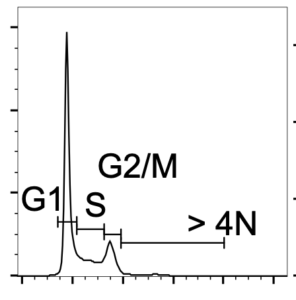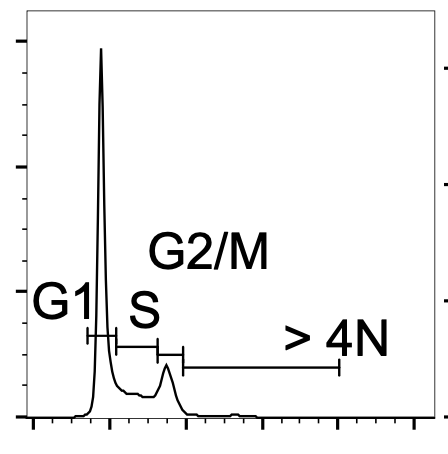 |
| Figure: Cell cycle map of eukaryotic cells. The X-axis represents DNA content, and Y-axis represents the number of cells. |
The cell cycle is the process by which a cell grows and divides into two daughter cells. It is a complex and tightly regulated process that is essential for the growth and development of all living organisms.
The cell cycle can be divided into two main phases: interphase and cell division. Interphase is further divided into three stages: G1, S, and G2. Cell division is divided into two stages: mitosis and cytokinesis.
During interphase, the cell grows and performs its normal functions. In the G1 stage, the cell grows and carries out its usual functions. In the S stage, the cell’s DNA is replicated, creating two identical copies of the genome. In the G2 stage, the cell prepares for division.
During mitosis, the cell’s nuclear material is divided into two equal sets, each of which will be inherited by one of the daughter cells. This is accomplished through a series of highly coordinated events.
First, the nuclear envelope, which surrounds the nucleus, breaks down and the chromosomes that carry the cell’s genetic material condense and become visible under a microscope. The chromosomes are then pulled to opposite poles of the cell by the mitotic spindle, a structure made up of microtubules.
Next, the cell’s cytoplasm, which contains all of the cell’s organelles, divides into two equal parts, each of which will be inherited by one of the daughter cells. This is accomplished through a process called cytokinesis.
In animal cells, cytokinesis is accomplished through the formation of a cleavage furrow, which is a shallow indentation that forms in the cell’s plasma membrane. As the cleavage furrow deepens, the cell’s cytoplasm is divided into two daughter cells.
In plant cells, cytokinesis is accomplished through the formation of a cell plate, which is a structure that forms in the middle of the cell. The cell plate then grows outward, eventually forming a new cell wall that divides the cell into two daughter cells.
After cytokinesis, the cell cycle is complete and the two daughter cells are ready to begin their own cell cycles.
Overall, the cell cycle is a complex and highly regulated process that is essential for the growth and development of all living organisms. It allows cells to grow, divide, and produce new cells that are genetically identical to the parent cell. Understanding the stages of the cell cycle is important for many areas of biology, including cancer research and the development of new treatments for diseases.

